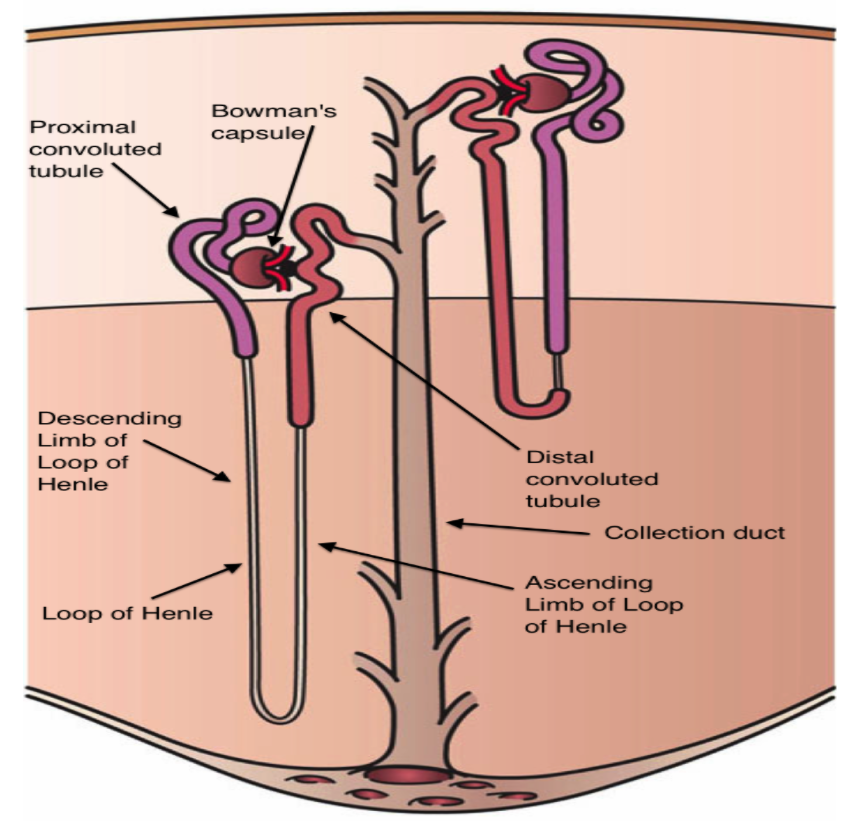
Write short notes on Nephron.
Answer
486.9k+ views
Hint: Nephrons are the structural and functional unit of the kidney. It is the complex microscopic structure whose main function is to produce urine and eliminate excess molecules and ions from the blood.
Complete Answer:
The excretory system of human beings is made up of long tubular structures called the nephrons.
Let's discuss the structure of nephron-

- Bowman ’s capsule: It is a cup like structure whose main function is ultrafiltration.
Glomerulus gets blood from afferent arterioles. It consists of a small tuft of capillaries through which blood flows in high pressure.
- The Loop of Henle is a hair-pin like structure. It comprises a thin ascending limb and thick descending limb. The fluid filtered through glomerulus reaches the collecting duct through the loop. Re-absorption of useful substances, especially water is the main function of this loop.
- Distal convoluted tubules have many mitochondria present in the cell lining. They produce energy required for active transport. It helps in reabsorption of calcium ions.
- Proximal convoluted tubule: Here salt water and organic solutes like glucose and amino acids are filtered.
- Collecting tubules is the last part of the tubules before entering the collecting duct. Re-absorption of water takes place in this tubule.
Function of Nephron:
- It regulates the ionic and molecular substances in blood.
- It maintains the homeostasis of blood by maintaining the blood pressure.
- It excretes the harmful substances and reabsorbs the useful ones.
Note: The kidney of a healthy adult has around 1 to 1.5 million nephrons per kidney. Kidneys detoxify our body. If the toxic substances get accumulated in our body, the function of nephrons is disturbed. This can lead to dialysis, kidney failure or even death. A person can survive with a single kidney as well.
Complete Answer:
The excretory system of human beings is made up of long tubular structures called the nephrons.
Let's discuss the structure of nephron-

- Bowman ’s capsule: It is a cup like structure whose main function is ultrafiltration.
Glomerulus gets blood from afferent arterioles. It consists of a small tuft of capillaries through which blood flows in high pressure.
- The Loop of Henle is a hair-pin like structure. It comprises a thin ascending limb and thick descending limb. The fluid filtered through glomerulus reaches the collecting duct through the loop. Re-absorption of useful substances, especially water is the main function of this loop.
- Distal convoluted tubules have many mitochondria present in the cell lining. They produce energy required for active transport. It helps in reabsorption of calcium ions.
- Proximal convoluted tubule: Here salt water and organic solutes like glucose and amino acids are filtered.
- Collecting tubules is the last part of the tubules before entering the collecting duct. Re-absorption of water takes place in this tubule.
Function of Nephron:
- It regulates the ionic and molecular substances in blood.
- It maintains the homeostasis of blood by maintaining the blood pressure.
- It excretes the harmful substances and reabsorbs the useful ones.
Note: The kidney of a healthy adult has around 1 to 1.5 million nephrons per kidney. Kidneys detoxify our body. If the toxic substances get accumulated in our body, the function of nephrons is disturbed. This can lead to dialysis, kidney failure or even death. A person can survive with a single kidney as well.
Recently Updated Pages
Master Class 11 English: Engaging Questions & Answers for Success

Master Class 11 Computer Science: Engaging Questions & Answers for Success

Master Class 11 Maths: Engaging Questions & Answers for Success

Master Class 11 Social Science: Engaging Questions & Answers for Success

Master Class 11 Physics: Engaging Questions & Answers for Success

Master Class 11 Chemistry: Engaging Questions & Answers for Success

Trending doubts
State and prove Bernoullis theorem class 11 physics CBSE

Raindrops are spherical because of A Gravitational class 11 physics CBSE

What are Quantum numbers Explain the quantum number class 11 chemistry CBSE

Write the differences between monocot plants and dicot class 11 biology CBSE

Why is steel more elastic than rubber class 11 physics CBSE

Explain why a There is no atmosphere on the moon b class 11 physics CBSE




